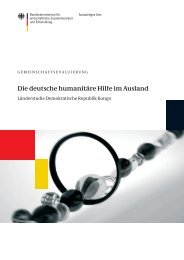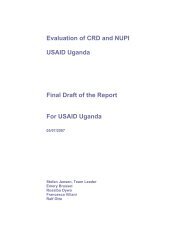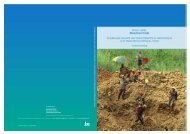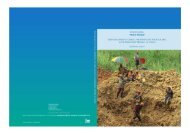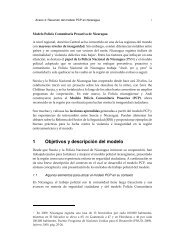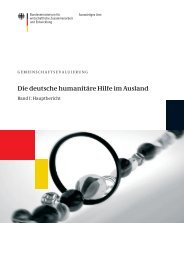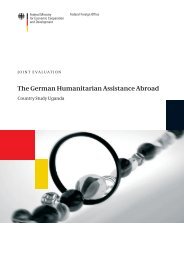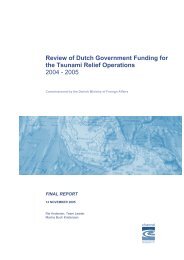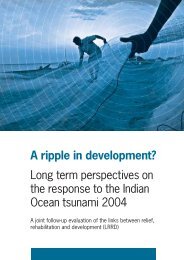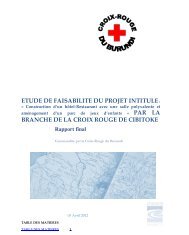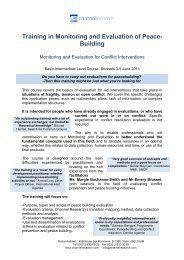Die deutsche humanitäre Hilfe im Ausland - Channel Research
Die deutsche humanitäre Hilfe im Ausland - Channel Research
Die deutsche humanitäre Hilfe im Ausland - Channel Research
Erfolgreiche ePaper selbst erstellen
Machen Sie aus Ihren PDF Publikationen ein blätterbares Flipbook mit unserer einzigartigen Google optimierten e-Paper Software.
that is known for humanitarian assistancein general due to the generally protractednature of humanitarian crises and theshort-term nature of the measures<strong>im</strong>plemented.Sustainability/connectednessLocal capacities are crucial for thesustainability and connectedness ofhumanitarian assistance. Frequently theactors involved in German humanitarianassistance l<strong>im</strong>it themselves to the use oflocal capacities in various forms andfunctions. In some cases, especially inemergency relief and in extendedemergency aid, certain measures still tendto take on “a life of their own” when<strong>im</strong>plementation by German<strong>im</strong>plementation partners continues.Although some examples of good practicedo exist for capacity developmentmeasures, the potential has not yet beensufficiently exploited.Cross-cutting issuesIn general, there is much scope for<strong>im</strong>provement in terms of taking intoaccount and realising cross-cutting issuesin German-funded humanitarianassistance. The cross-cutting issues(human rights, gender, conflictsensitivity/do no harm, environmentalsoundness, HIV and AIDS as well asprotection) are currently mainstreamed tovarying degrees in German humanitarianassistance. While a number of theseissues are taken into greater and moresystematic consideration by internationalorganisations, in some cases throughorganisation-wide initiatives, and whilethey are institutionally anchored within theDeutsche Gesellschaft für TechnischeZusammenarbeit (since 1 January 2011the Deutsche Gesellschaft fürInternationale Zusammenarbeit) throughthe DAC markers, the commitment of mostnon-governmental organisations to thesecross-cutting issues is still rud<strong>im</strong>entary.Some have anchored the issues in theirstrategies, concepts and forms, indicatingsensitivity to these issues, but this is stillno guarantee that they will beappropriately realised. When projects are<strong>im</strong>plemented there are some specificactivities for gender and conflictsensitivity/do no harm, but the issues arestill not systematically taken into account.The potentials and capacities availablewithin German humanitarian assistanceand development cooperationorganisations have not yet beenadequately exploited.Linking relief, rehabilitation anddevelopment (LRRD)Although it is generally accepted thatlinking relief, rehabilitation anddevelopment must be seen as acontiguum, rather than a continuum, inpractice the latter approach tends todominate in the way actors think and act,and in the pertinent discourse. To date theLRRD debate in relation to Germanhumanitarian assistance in fragile states isstill not sufficiently dovetailed withengagement for a whole-of-governmentapproach.A number of actors involved in Germangovernment-funded humanitarianassistance have a wealth of conceptualand practical experience in linking relief,rehabilitation and development and inconflict-sensitive cooperation in fragilestates. The German government also hasin place suitable mechanisms to respondappropriately in different contexts with itstwo specific budget lines for humanitarianemergency relief and developmentorientedemergency and transitional aid(adjustments need, however, to be madeto the low commitment appropriations inthe BMZ budget line for developmentorientedemergency and transitional aid).The German government does not,however, yet use these mechanisms andthe specific potential they offer in axv



